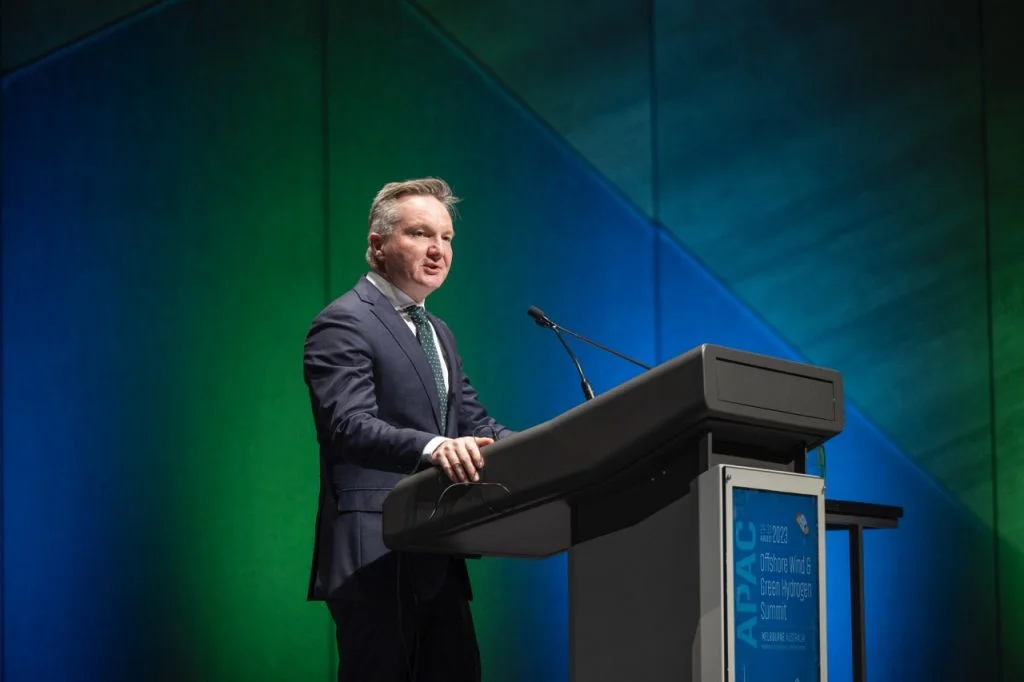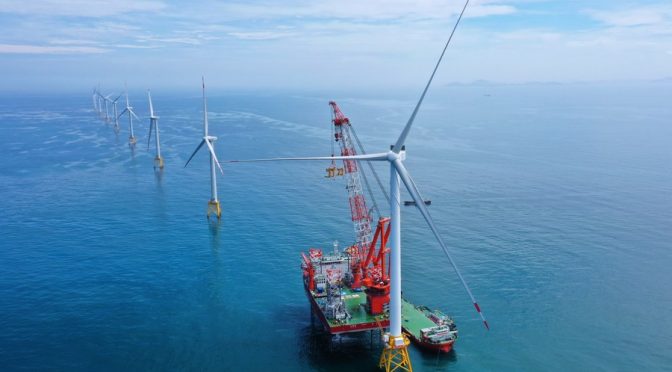Chris Bowen MP, Australia’s Minister for Climate Change and Energy, announced today at GWEC’s APAC Summit the next two rounds of consultation for offshore wind zones in the country. The Bass Straight region and the Perth/Bunbury zone consultations will begin in October and November, respectively. Minister Bowen told the conference that this announcement, “puts us firmly on track to have all six areas declared by the first half of next year.”
The inaugural APAC Summit is focused on fostering collaboration across the industry, with Chris Bowen acknowledging that he was, “providing this roadmap today because I know it will give industry certainty about the immediate path ahead.”
Australia is “firmly on track to have all six [offshore wind] areas declared by the first half of next year”Chris Bowen MP, Australia’s Minister for Climate Change and Energy,
In a Q&A with GWEC CEO Ben Backwell at the event, Minister Bowen stressed the importance of these consultations, explaining it was important to have the “conversation openly and respectfully and say ‘yes, these are issues that need to be worked through. But here’s all the massive opportunities for our country.’”
Today’s announcement at the APAC Summit means Australia has progressed all six of its consultations within twelve months. “The pace of Australia’s development in the last year has been fantastic,” said Ben Backwell, GWEC, CEO, at the APAC Summit. “Minister Bowen described Australia as being like ‘the kid studying all night to catch up,’ when it came to renewable energy, but I think we can safely say the government’s work over the last twelve months now makes it a model for other countries looking to build their offshore wind sector.

Chris Bowen MP, Australia’s Minister for Climate Change and Energy, at GWEC’s APAC Summit in Melbourne (Credit: GWEC)
“Australia has embraced international cooperation, joining the Global Offshore Wind Alliance (GOWA) to help foster collaboration across the world. The Australian government has also become a model for local engagement, with the federal government’s support for the State of Victoria joining GOWA yesterday at the Summit, the first sub-national government to do so, showing it understands that engagement at all levels is crucial to delivering the full benefits of offshore wind’s potential.
“GWEC looks forward to growing its involvement in the region as Australia builds its offshore wind sector, and helps the APAC Summit deliver on its enormous offshore potential.”
The APAC Summit concludes on Thursday with an Offshore Wind Open Day, where the exhibition is free to attend for job seekers and anyone looking to gain a better understanding of what opportunities the offshore wind sector will provide.
Contact: Alex Bath, Communications Director, alex.bath@gwec.net
For reference:
Minister Bowen’s comments on the new consultations in full:
“Twelve months ago we announced the first steps in creating a new renewable energy industry, with the announcement of six proposed regions with world-class offshore wind energy potential.
I have declared the first two zones. Gippsland and Hunter.
We’ve begun consultation on the next two zones – Illawarra and the Southern Ocean region.
And today, I’m pleased to announce the next steps.
Firstly – the Bass Strait region, off the Tasmanian Coast.
Consultation for this region will start at the beginning of October.
Secondly, the Perth/Bunbury region off the coast of Western Australia.
I announce today the consultation will begin on this zone in November.
This puts us firmly on track to have all six areas declared by the first half of next year.
I’m providing this roadmap today because I know it will give industry certainty about the immediate path ahead.
It will also give visibility to communities about the conversations coming up.
These are important conversations, and I heard the chief executive talk about the importance of community consultation. And I wholeheartedly agree.
Community consultation is critical to our success.
It’s not a rubber stamp process – it’s not a fig leaf.
This is genuine conversation, listening to different perspectives, and making sure the balance right.
The two zones I have declared so far: Gippsland and Hunter, both have changed from the originally proposed zones as a result of community consultation. This is as it should be. It is the process working.
I want to say this to you clearly and frankly too: our government consultation is better and smoother if proponents have engaged in real, respectful and informed consultations with communities.
Later this year, Australia’s Energy Infrastructure Commissioner will be publishing the first guide for communities and developers on how best to engage in Australia.
This will provide more guidance to developers and clearly lay out the process to communities for consultation.
We’ve been able to bring this work forward because of our Government’s increased investment in the development of the Australian offshore wind industry.
Australia has some of the best offshore wind resources anywhere in the world, and we’re pleased to be open for business.
But I also want to be clear with you about this. We’re interested in renewable energy.
We’re also interested in jobs, local content and economic development as well as supply chain.
I’m not here to pretend to you that Australia can fulfil all the entire offshore wind supply chain.
But we can fulfil a role increasingly in that supply chain and we want to see real economic dividends.
Proponents with proper plans for local economic content, job creation and growth will have the attention and co-operation of the Government.
This is especially the case for our regions.
Take our first offshore wind zone for example.
Gippsland is a couple of hours from here.
It’s a beautiful part of the world.
It’s also home to Victoria’s coal fired power stations.
Power stations that won’t be replaced with new ones when they close.
It is no co-incidence that we chose Gippsland as our first offshore wind zone.
It’s rich in wind.
We want it to be rich in jobs too.
Not just jobs for existing coal fired power station workers. But for their kids who want to stay in the region.
Offshore wind is an important part of that vision and I invite offshore wind proponents to really focus on the economic dividend for the regions in which they seek to be located.”

